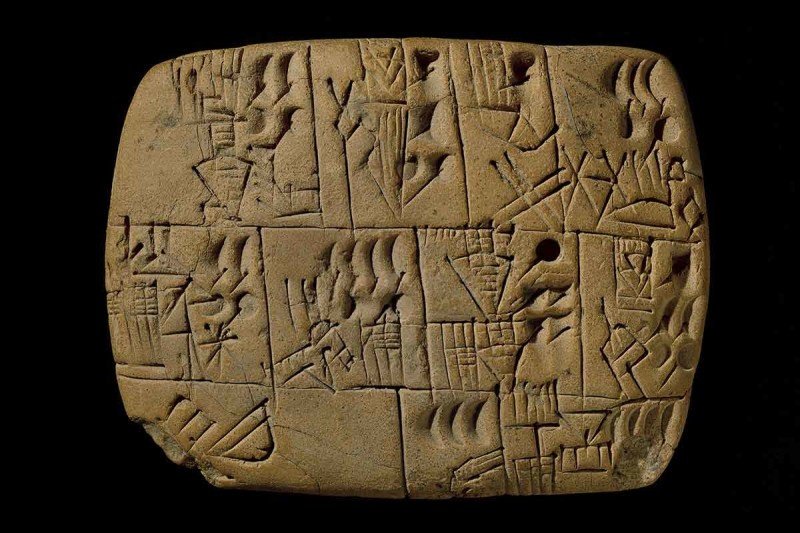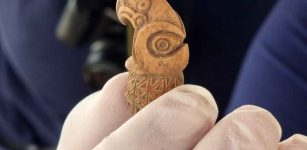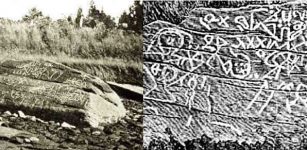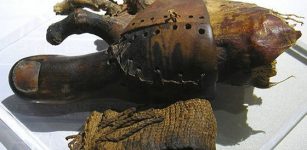World’s Oldest Paycheck Reveals Ancient Sumerian Workers Were Paid In Beer
A. Sutherland - AncientPages.com - A roughly 5,000-year-old cuneiform stone tablet, in possession of the British Museum in London shows how workers were paid their daily rations in liquid gold.
We have previously seen that the oldest evidence of beer was found on a Sumerian tablet in Mesopotamia.
The drink was apparently so popular that ancient Sumerian workers were paid for their labor in beer and this practice was widely known in ancient world.

A 5,000-year-old cuneiform tablet from the ancient Mesopotamian city of Uruk depicts the distribution of beer to workers as part of their daily rations.
The tablet made around 3100 to 3000 BC. , excavated from Uruk , an ancient city of Sumer and later Babylonia, situated east of the present bed of the Euphrates river, depicts a human head eating from a bowl, meaning ‘ration,' and a conical vessel, meaning ‘beer. There are undoubtedly several reasons why beer was so popular in Mesopotamia. The drink was was safer and tasted better than water.
The Sumerian workers were not the only one who received payment in form of beer. Beer was also of central importance to ancient Egyptian society. Beer was the staple drink of ancient Egyptian workers and craftsmen while wine was for rich people.
See also:
Walls Of Uruk Built By Sumerian King Gilgamesh 4,500 Years Ago
Oldest Evidence Of Beer Was Found On A Sumerian Tablet In Mesopotamia
In ancient Egypt, workers often received wages were often paid in beer and other supplies and the workmen living in the workers village at Giza received beer three times a day as part of their rations. A daily ration could be as much as four to five liters beer.
There are also records of poet and the “Father of English literature” Geoffrey Chaucher receiving a yearly salary of 252 gallons of wine from Richard II.
Receiving wages in form of alcohol has happened on several occasions throughout history, and the trend is still practiced by some modern companies.
Ancient Egyptians also valued beer and used it not only to get drunk, but as medicine and payment. Beer was of great importance in the ancient Egyptian society and its existence gave women an opportunity to earn extra money.
Wages were often paid in beer and workers living in the workers village at Giza received beer three times a day as part of their rations. Archaeologists excavating in Egypt have discovered that payment through beer was very common in various parts of the country.
Written by – A. Sutherland - AncientPages.com Senior Staff Writer
Copyright © AncientPages.com All rights reserved. This material may not be published, broadcast, rewritten or redistributed in whole or part without the express written permission of AncientPages.com
More From Ancient Pages
-
 Neanderthal Genes Influence Your Mood And Much More – Study Shows
Archaeology | Oct 6, 2017
Neanderthal Genes Influence Your Mood And Much More – Study Shows
Archaeology | Oct 6, 2017 -
 3,000-Year-Old Silver Goblet That May Have Belonged To Mannaea Kingdom – Unearthed
Archaeology | Apr 3, 2019
3,000-Year-Old Silver Goblet That May Have Belonged To Mannaea Kingdom – Unearthed
Archaeology | Apr 3, 2019 -
 Sonar Images Reveal The Existence Of A 700-Year-Old Shipwreck At The Bottom Of Lake Mjøsa, Norway
Archaeology | Nov 22, 2022
Sonar Images Reveal The Existence Of A 700-Year-Old Shipwreck At The Bottom Of Lake Mjøsa, Norway
Archaeology | Nov 22, 2022 -
 Scythians Were Not Always Nomadic Warriors Of The Pontic Steppe In Black Sea Region
Archaeology | Mar 19, 2021
Scythians Were Not Always Nomadic Warriors Of The Pontic Steppe In Black Sea Region
Archaeology | Mar 19, 2021 -
 Rare 2,500-Year-Old Scythian Bone Sceptre Discovered In Bulgaria
Archaeology | Oct 3, 2023
Rare 2,500-Year-Old Scythian Bone Sceptre Discovered In Bulgaria
Archaeology | Oct 3, 2023 -
 5 Surprising Things DNA Has Revealed About Our Ancestors
DNA | Sep 27, 2023
5 Surprising Things DNA Has Revealed About Our Ancestors
DNA | Sep 27, 2023 -
 New Insight On What Ancient Noses Smelled
Archaeology | Mar 29, 2023
New Insight On What Ancient Noses Smelled
Archaeology | Mar 29, 2023 -
 Gryla: Cannibalistic, Evil Troll And Her Sons ‘Yule Lads’ – In Icelandic Folklore
Christmas Traditions | Dec 23, 2024
Gryla: Cannibalistic, Evil Troll And Her Sons ‘Yule Lads’ – In Icelandic Folklore
Christmas Traditions | Dec 23, 2024 -
 Orichalcum: Mysterious Metal Linked To Legendary Atlantis Discovered In Shipwreck
Archaeology | Jan 8, 2015
Orichalcum: Mysterious Metal Linked To Legendary Atlantis Discovered In Shipwreck
Archaeology | Jan 8, 2015 -
 Dighton Rock – Centuries-Old-Mystery Still Unsolved
Featured Stories | Sep 8, 2015
Dighton Rock – Centuries-Old-Mystery Still Unsolved
Featured Stories | Sep 8, 2015 -
 The Fierce Great Heathen Army And The Invasion Of East Anglia
Vikings | Aug 8, 2022
The Fierce Great Heathen Army And The Invasion Of East Anglia
Vikings | Aug 8, 2022 -
 DNA Study Shows Pre-Historic Wallacea Was A Melting Pot Of Human Genetic Ancestries
Archaeology | Jun 9, 2022
DNA Study Shows Pre-Historic Wallacea Was A Melting Pot Of Human Genetic Ancestries
Archaeology | Jun 9, 2022 -
 DNA Analyses Suggest The Plague Contributed To Stone Age Farmers’ Decline
Archaeology | Jul 10, 2024
DNA Analyses Suggest The Plague Contributed To Stone Age Farmers’ Decline
Archaeology | Jul 10, 2024 -
 Uncovering Ancient Secrets Hidden In China’s Dunhuang Caves
News | Jan 13, 2021
Uncovering Ancient Secrets Hidden In China’s Dunhuang Caves
News | Jan 13, 2021 -
 3,000-Year-Old Egyptian Artificial Wooden Toe In New Light
Archaeology | Jun 20, 2017
3,000-Year-Old Egyptian Artificial Wooden Toe In New Light
Archaeology | Jun 20, 2017 -
 Prince Wenceslaus Of Bohemia Murdered On Order Of His Own Brother
Featured Stories | Nov 19, 2019
Prince Wenceslaus Of Bohemia Murdered On Order Of His Own Brother
Featured Stories | Nov 19, 2019 -
 Murder Of Bardiya: Son Of Cyrus The Great And The Riddle Of The Impostor
Historical Figures | Dec 7, 2018
Murder Of Bardiya: Son Of Cyrus The Great And The Riddle Of The Impostor
Historical Figures | Dec 7, 2018 -
 LIDAR Data Helped To Discover Unexplored Region Of Maya World In Campeche, Mexico
Archaeology | Oct 29, 2024
LIDAR Data Helped To Discover Unexplored Region Of Maya World In Campeche, Mexico
Archaeology | Oct 29, 2024 -
 2000-Year-Old Room With Frescoes Discovered In Central Rome, Italy
Archaeology | Dec 4, 2015
2000-Year-Old Room With Frescoes Discovered In Central Rome, Italy
Archaeology | Dec 4, 2015 -
 Archaeologists Refute Claims That A Comet Destroyed Hopewell Culture
Archaeology | Aug 11, 2023
Archaeologists Refute Claims That A Comet Destroyed Hopewell Culture
Archaeology | Aug 11, 2023
